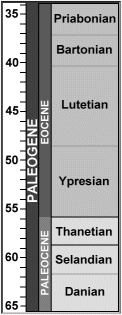| |

The abundance of Paleogene sharks bearing sand tiger-like teeth creates a background noise that often makes identifications difficult. Although most genera have characteristic features, they often overlap with variations expressed by other genera. As a result, the tooth-designs of only a few file positions tend to become diagnostic and are repeated by multiple authors. In addition to the mindset created by these repeated examples, specimens weakly displaying 'key' features further hamper identification. I doubt that I'm unique if I confess that many of my finds end-up in a bag labeled "sand tiger-type" teeth. As one becomes more knowledgeable, less material makes its way to this destination, but it still exists.
Palaeohypotodus is one of these genera. When a key feature, such as the strong basio-labial folds, are present (see figure ), they can be readily identified. I'm less certain that variations of Palaeohypotodus teeth lacking this feature haven't worked their way into my catch-all sand tiger bag.
In 1964, Glikman erected the family Jaekelotodontidae for the teeth of Palaeohypotodus, which transition into Jaekelotodus. Zhelezko & Kozlov (1999) attribute four species to Palaeohypotodus, speyeri (DARTEVELLE & CASIER 1943), volgensis ZHELEZKO, 1999, rutoti ( WINKELR, 1874b) and lerichei GLIKMAN 1964. They include three species (with 12 named stages) to Jaekelotodus: londonensis ZHELEZKO, 1994, borystenicus GLIKMAN 1964 and trigonalis (JAEKEL, 1895). Cappetta (1987) rejected Glikman's erection of the new family based solely on tooth-design, and included Palaeohypotodus (and Jaekelotodus) in Odontaspididae.
Anterior teeth of this genus have a rather robust appearance derived from a strong protuberance and short stout cusp. The lingual crown face is smooth, the cutting-edge complete, the roots are rather narrow, have rounded tips and bear a strong nutrient groove. The cusps of upper lateral teeth are broader, thinner and (strongly) curved in a distal direction, while lower laterals are more erect/straight. The root has a flatter basal face, rounded tips and the nutrient groove remains strong. Both anterior and lateral teeth have two (or three) well-separated cusplets on each shoulder. The primary cusplets are moderately strong and the secondary, greatly reduced. The lower labial crown face overhangs the root and bears moderate to strong folds. Cappetta (1987) states that the base of the cutting edge, particularly in lateral teeth, may be serrate. It is important to note that although the folds of the lower labial crown face are broadly thought to be diagnostic, they may not be present (see figure ).

Cappetta noted that P. rutoti teeth had been found in the Palaeocene of Europe, North Africa and Greenland. Ward & Weist (1990) reported this species from the Brightseat and Aquia Formations (Palaeocene) of the Chesapeake Region and Eocene of Europe. Purdy (1998) reported this species from the Williamsburg Formation (Thanetian - Late Palaeocene) of South Carolina.
Kent (1999) included P. rutoti in the Eocene of Virginia and Zhelezko & Kozlov (1999) reported them from the Palaeocene of Kazakhstan. Cappetta & Nolf (2005: 250) refer to this genus as being monospecific. They do not account for or mention Palaeohypotodus bronni (AGASSIZ, 1843) which has been reported from the Maastrichtian of Belgium & the Netherlands and the Danian of Denmark (Herman 1977).
The junior author notes that when comparing the Palaeohypotodus specimens from Lille (Thanetian of Northern France) with teeth from elsewhere, the basal denticles of the labial face are more pronounced (ref image 3), the design more graceful and the cusplets more expressive.
He went on to note that in the middle Thanetian of France (Moreau & Mathis 2000) and Belgium, Palaeohypotodus is one of the most common large species; in the upper Thanetian, Palaeohypotodus is becoming very scarce and J. robustus is getting less scarce (but still not common).
Selected References
Cappetta, H. 1987. Chondrichthyes II. Mesozoic and Cenozoic Elasmobranchii. In: Handbook of Paleoichthyologie, vol. 3b, Gustav Fischer Verleg, Stuttgart, 193 pp.
Cappetta, H & Nolf, D, 2005. Revision de quelques Odontaspidae (Neoselachii: Lamniformes) du Paleocene et de l'Eocene du Bassin de la mer du Nord Bulletin de l'institut Royal des Sciences Naturelles de Belgique, Sciences de la Terre 75: 237-266.
Glikman, L., 1964. Akuly paleogena i ikh stratigraficheskoe znachenie Akademii Nauk Soyuza Sovetskikh Sotsialisticheskikh Respublik, 1-228 Moscow.
Herman, J., 1977. Les sélaciens des terrains néocrétacés et paléocènes de Belgique et des contrées limitrophes. Eléments d'une biostratigraphie intercontinentale. Mémoires pour servir à l'explication des Cartes géologiques et minières de la Belgique, 1975 (paru 1977), 15: 401 pp.
Kent, B. 1999. Sharks from the Fisher/Sullivan Site. In: Weems, R. & Grimsley, G., Early Eocene Vertebrates and Plants from the Fisher/Sullivan Site (Nanjemoy Formation) Stafford County, Virginia. Virginia Division of Mineral Resources, Pub 152: 11-37.
Moreau, F. & Mathis, S. 2000. Les élasmobranches du Thanétien (Paléogène) du nord de la France, des carrières de Templeuve et de Leforest. Cossmanniana.
Purdy, R. 1998. Chondrichthyan Fishes from the Paleocene of South Carolina. In: Paleobiology of the Williamsburg Formation (Black Mingo Group; Paleocene) of South Carolina, U.S.A., Albert Sanders ed. Transactions of Amer. Philo. Scty., vol 8 (4), pp 122-146.
Ward, D. J. and Wiest, R.L., 1990. A checklist of Paleocene and Eocene sharks and rays (Chondrichthyes) from the Pamunkey Group, Maryland and Virginia, USA. Tertiary Res., 12(2): 81-88.
Winkler, T.C., 1874b. Deuxième mémoire sur des dents de poissons fossiles du terrain bruxellien. In: Archives du Musée Teyler, 1878; vol. IV (fasc. 1, 1876), pp 16-48; Extrait, 10 pages. Les Héritiers Loosjes, Haarlem, Belgium.
Zhelezko , V. I. & Kozlov, V. A. 1999. Elasmobranchii and Palaeogene biostratigraphy of Transurals and Central Asia. Materials on stratigraphy and Palaeontology of the Urals Vol. 3. Russian Academy of Sciences Urals Branch Uralian Regional Interdepartment Stratigraphical Comissian, Ekkaterinburg. 324 pp, 61 pls.
|